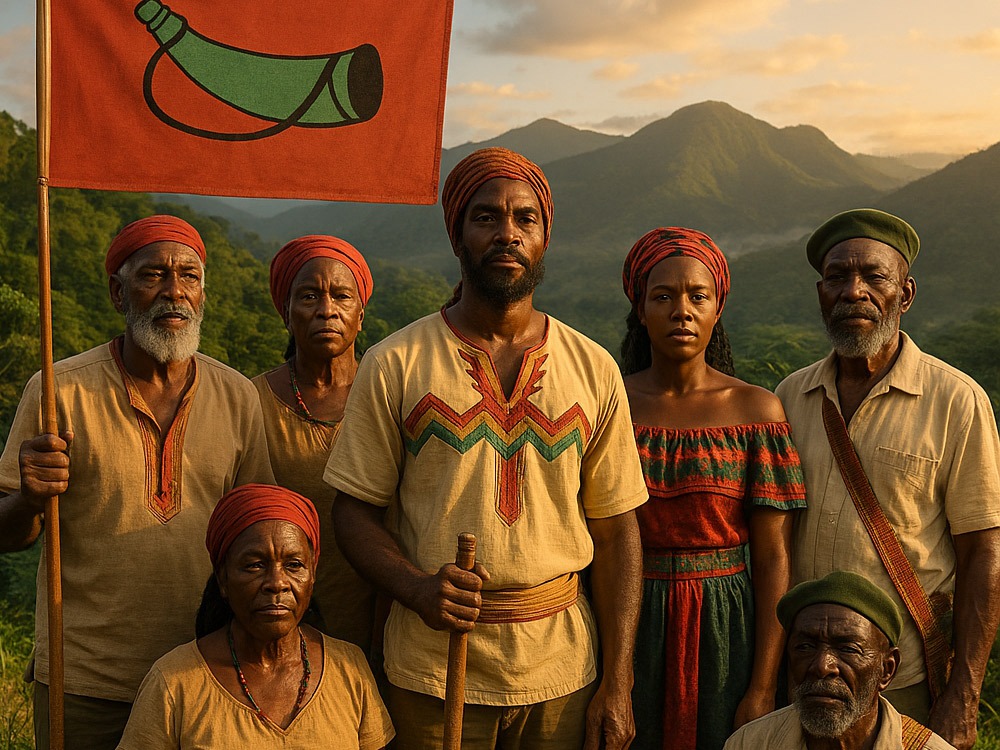In the lush, mountainous interior of Jamaica lies a powerful story of survival, sovereignty, and defiance. Maroon communities, descendants of formerly enslaved Africans who escaped colonial bondage, have stood their ground for over 300 years. Today, they are once again defending themselves—this time not against British colonizers, but against foreign mining interests, environmental threats, and state encroachment.
Across the island, from Accompong in the west to Moore Town, Charles Town, and Scotts Hall in the east, each Maroon community is using unique strategies to protect its land, culture, and people.
Accompong Maroons (St. Elizabeth/Cockpit Country)
Capital of Sovereign Resistance
Led by Chief Richard Currie, the Accompong Maroons are taking a firm stand against proposed bauxite mining in Cockpit Country, a biologically rich region essential to Jamaica’s water supply and cultural heritage.
Their strategies include:
-
Declaring sovereign no-mining zones within their territory.
-
Issuing cease-and-desist letters to companies attempting to mine on Maroon lands.
-
Filing lawsuits asserting rights under the 1739 Treaty with the British and Jamaican constitutional law.
-
Raising awareness through YouTube documentaries like this one and engaging global audiences on Instagram and Twitter.
“Our sovereignty is not a myth; it is a lived reality.” – Chief Richard Currie
Moore Town Maroons (Portland)
Defenders of Nanny’s Legacy
Moore Town is the birthplace of Queen Nanny, Jamaica’s only National Heroine. The Maroons here are known for their spiritual connection to the land and ceremonial traditions, including the use of the Abeng horn.
Their resistance includes:
-
Guarding sacred ancestral sites from development and mining.
-
Conducting cultural education and ceremonies to pass on Maroon values.
-
Participating in dialogues about indigenous rights, aligned with international frameworks like ILO Convention 169.
“To disturb the land is to disturb our ancestors.” – A Moore Town elder
Charles Town Maroons (Portland)
Cultural Revival and Diplomatic Resistance
The Charles Town Maroons focus on cultural preservation as resistance. Through heritage tourism, academic partnerships, and local events, they elevate the Maroon story while defending their community from external threats.
Key efforts include:
-
Hosting the annual Charles Town Maroon Festival, attracting local and international support.
-
Promoting sustainable development and cultural education.
-
Forming alliances with scholars and indigenous rights groups worldwide.
Scotts Hall Maroons (St. Mary)
Quiet Strength, Growing Voice
Though historically quieter, the Scotts Hall Maroons are asserting themselves more in recent years. As their awareness of environmental and legal threats grows, so too does their activism.
Their actions include:
-
Advocating for recognition of treaty rights in national court proceedings.
-
Participating in community consultations on land use.
-
Collaborating with other Maroon towns to form a unified national voice against harmful development.
Maroons Across Jamaica: One Spirit, Many Voices
Despite differences in geography and leadership, all of Jamaica’s Maroon communities are aligned in their mission: to defend their rights, their lands, and their legacy. Together, they:
-
Invoke their treaty-based sovereignty, backed by international law.
-
Oppose foreign mining that threatens sacred ecosystems like Cockpit Country.
-
Use platforms like YouTube, Linktree, and global media to tell their story.
-
Build solidarity across the Caribbean and beyond in the fight for environmental justice.
“We are not just defending trees and rivers—we are defending our children’s future.”
Why This Struggle Matters
The Maroons are not merely protecting villages—they are defending Jamaica’s ecological lungs, cultural soul, and ancestral memory. Their stand is part of a broader global movement in which indigenous and tribal peoples are resisting environmental degradation, asserting their legal rights, and redefining sustainable development.
Learn More and Take Action
-
Watch: How a Sovereign Group in Jamaica Is Fighting a US Mining Company (YouTube)
-
Support the Movement: State of Accompong Official Linktree
-
Understand the Issue: Jamaica Environment Trust – Cockpit Country
-
Know the Law: ILO Convention 169 – Indigenous Rights
